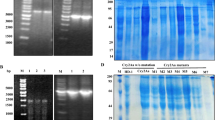Abstract
Cry1Ac insecticidal crystal proteins produced by Bacillus thuringiensis (Bt) have become an important natural biological agent for the control of lepidopteran insects. In this study, a cry1Ac toxin gene from Bacillus thuringiensis 4.0718 was modified by using error-prone PCR, staggered extension process (StEP) shuffling combined with Red/ET homologous recombination to investigate the insecticidal activity of delta-endotoxin Cry1Ac. A Cry1Ac toxin variant (designated as T524N) screened by insect bioassay showed increased insecticidal activity against Spodoptera exigua larvae while its original insecticidal activity against Helicoverpa armigera larvae was still retained. The mutant toxin T524N had one amino acid substitution at position 524 relative to the original Cry1Ac toxin, and it can accumulate within the acrystalliferous strain Cry-B and form more but a little smaller bipyramidal crystals than the original Cry1Ac toxin. Analysis of theoretical molecular models of mutant and original Cry1Ac proteins indicated that the mutation T524N located in the loop linking β16–β17 of domain III in Cry1Ac toxin happens in the fourth conserved block which is an arginine-rich region to form a highly hydrophobic surface involving interaction with receptor molecules. This study showed for the first time that single mutation T524N played an essential role in the insecticidal activity. This finding provides the biological evidence of the structural function of domain III in insecticidal activity of the Cry1Ac toxin, which probably leads to a deep understanding between the interaction of toxic proteins and receptor macromolecules.




Similar content being viewed by others
References
Roh JY, Choi JY, Li MS, Jin BR, Je YH (2007) Bacillus thuringiensis as a specific, safe, and effective tool for insect pest control. J Microbiol Biotechnol 17:547–559
Schnepf E, Crickmore N, Van Rie J, Lereclus D, Baum J, Feitelson J, Zeigler DR, Dean DH (1998) Bacillus thuringiensis and its pesticidal crystal proteins. Microbiol Mol Biol Rev 62:775–806
van Frankenhuyzen K (2009) Insecticidal activity of Bacillus thuringiensis crystal proteins. J Invertebr Pathol 101:1–16
Bravo A, Gill SS, Soberón M (2007) Mode of action of Bacillus thuringiensis Cry and Cyt toxins and their potential for insect control. Toxicon 49:423–435
Soberón M, Gill SS, Bravo A (2009) Signaling versus punching hole: how do Bacillus thuringiensis toxins kill insect midgut cells? Cell Mol Life Sci 66:1337–1349
Romero PA, Arnold FH (2009) Exploring protein fitness landscapes by directed evolution. Nat Rev Mol Cell Biol 10:866–876
Stemmer WP (1994) DNA shuffling by random fragmentation and reassembly: in vitro recombination for molecular evolution. Proc Natl Acad Sci USA 91:10747–10751
Stemmer WP (1994) Rapid evolution of a protein in vitro by DNA shuffling. Nature 370:389–391
Xiong AS, Peng RH, Liu JG, Zhuang J, Qiao YS, Xu F, Cai B, Zhang Z, Chen JM, Yao QH (2007) High efficiency and throughput system in directed evolution in vitro of reporter gene. Appl Microbiol Biotechnol 74:160–168
Kaur J, Sharma R (2006) Directed evolution: an approach to engineer enzymes. Crit Rev Biotechnol 26:165–199
Knight JS, Broadwell AH, Grant WN, Shoemaker CB (2004) A strategy for shuffling numerous Bacillus thuringiensis crystal protein domains. J Econ Entomol 97:1805–1813
Shu C, Liu R, Wang R, Zhang J, Feng S, Huang D, Song F (2007) Improving toxicity of Bacillus thuringiensis strain contains the cry8Ca gene specific to Anomala corpulenta larvae. Curr Microbiol 55:492–496
Craveiro KI, Júnior JE, Silva MC, Macedo LL, Lucena WA, Silva MS, Júnior JD, Oliveira GR, Magalhães MT, Santiago AD, Grossi-de-Sa MF (2010) Variant Cry1Ia toxins generated by DNA shuffling are active against sugarcane giant borer. J Biotechnol 145:215–221
Grochulski P, Masson L, Borisova S, Pusztai-Carey M, Schwartz JL, Brousseau R, Cygler M (1995) Bacillus thuringiensis CryIA(a) insecticidal toxin: crystal structure and channel formation. J Mol Biol 254:447–464
Morse RJ, Yamamoto T, Stroud RM (2001) Structure of Cry2Aa suggests an unexpected receptor binding epitope. Structure 9:409–417
Li JD, Carroll J, Ellar DJ (1991) Crystal structure of insecticidal delta-endotoxin from Bacillus thuringiensis at 2.5 A resolution. Nature 353:815–821
Galitsky N, Cody V, Wojtczak A, Ghosh D, Luft JR, Pangborn W, English L (2001) Structure of the insecticidal bacterial delta-endotoxin Cry3Bb1 of Bacillus thuringiensis. Acta Crystallogr D 57:1101–1109
Boonserm P, Mo M, Angsuthanasombat C, Lescar J (2006) Structure of the functional form of the mosquito larvicidal Cry4Aa toxin from Bacillus thuringiensis at a 2.8-angstrom resolution. J Bacteriol 188:3391–3401
Boonserm P, Davis P, Ellar DJ, Li J (2005) Crystal structure of the mosquito-larvicidal toxin Cry4Ba and its biological implications. J Mol Biol 348:363–382
Zhao XM, Xia LQ, Ding XZ, Wang FX (2009) The theoretical three-dimensional structure of Bacillus thuringiensis Cry5Aa and its biological implications. Protein J 28:104–110
Lebel G, Vachon V, Préfontaine G, Girard F, Masson L, Juteau M, Bah A, Larouche G, Vincent C, Laprade R, Schwartz JL (2009) Mutations in domain I interhelical loops affect the rate of pore formation by the Bacillus thuringiensis Cry1Aa toxin in insect midgut brush border membrane vesicles. Appl Environ Microbiol 75:3842–3850
Likitvivatanavong S, Katzenmeier G, Angsuthanasombat C (2006) Asn183 in alpha5 is essential for oligomerisation and toxicity of the Bacillus thuringiensis Cry4Ba toxin. Arch Biochem Biophys 445:46–55
de Maagd RA, Bravo A, Crickmore N (2001) How Bacillus thuringiensis has evolved specific toxins to colonize the insect world. Trends Genet 17:193–199
Aronson AI, Wu D, Zhang C (1995) Mutagenesis of specificity and toxicity regions of a Bacillus thuringiensis protoxin gene. J Bacteriol 177:4059–4065
Zhang Y, Buchholz F, Muyrers JP, Stewart AF (1998) A new logic for DNA engineering using recombination in Escherichia coli. Nat Genet 20:123–128
Zhang Y, Muyrers JP, Testa G, Stewart AF (2000) DNA cloning by homologous recombination in Escherichia coli. Nat Biotechnol 18:1314–1317
Ding XZ, Xia LQ (2001) Screening of a highly toxic insecticidal strain 4.0718 of Bacillus thuringiensis. Chin J Biol Control 17:163–166
Arvidson H, Dunn PE, Strnad S, Aronson AI (1989) Specificity of Bacillus thuringiensis for lepidopteran larvae: factors involved in vivo and in the structure of a purified protoxin. Mol Microbiol 3:1533–1543
López-Meza JE, Federici BA, Poehner WJ, Martínez-Castillo AM, Ibarra JE (1995) Highly mosquitocidal isolates of Bacillus thuringiensis subspecies kenyae and entomocidus from Mexico. Biochem Syst Ecol 23:461–468
Sambrook J, Fritsh EF, Maniatis T (1989) Molecular cloning. A laboratory manual, 2nd edn. Cold Spring Harbor Laboratory, Cold Spring Harbor, NY
An Y, Ji J, Wu W, Huang R, Wei Y, Xiu Z (2008) Random mutagenesis and recombination of sam1 gene by integrating error-prone PCR with staggered extension process. Biotechnol Lett 30:1227–1232
Hu SB, Liu P, Ding XZ, Yan L, Sun YJ, Zhang YM, Li WP, Xia LQ (2009) Efficient constitutive expression of chitinase in the mother cell of Bacillus thuringiensis and its potential to enhance the toxicity of Cry1Ac protoxin. Appl Microbiol Biotechnol 82:1157–1167
Lee MK, You TH, Gould FL, Dean DH (1999) Identification of residues in domain III of Bacillus thuringiensis Cry1Ac toxin that affect binding and toxicity. Appl Environ Microbiol 65:4513–4520
Xia LQ, Wang FX, Ding XZ, Zhao XM, Fu ZJ, Quan MF, Yu ZN (2008) The role of β18-β19 loop structure in insecticidal activity of Cry1Ac toxin from Bacillus thuringiensis. Chin Sci Bull 53:3178–3184
Bradford MM (1976) A rapid and sensitive method for the quantitation of microgram quantities of protein utilizing the principle of protein–dye binding. Anal Biochem 72:248–254
Liao C, Heckel DG, Akhurst R (2002) Toxicity of Bacillus thuringiensis insecticidal proteins for Helicoverpa armigera and Helicoverpa punctigera (Lepidoptera: Noctuidae), major pests of cotton. J Invertebr Pathol 80:55–63
Liu XS, Dean DH (2006) Redesigning Bacillus thuringiensis Cry1Aa toxin into a mosquito toxin. Protein Eng Des Sel 19:107–111
Guex N, Peitsch MC (1997) SWISS-MODEL and the Swiss-PdbViewer: an environment for comparative protein modeling. Electrophoresis 18:2714–2723
Burton SL, Ellar DJ, Li J, Derbyshire DJ (1999) N-acetylgalactosamine on the putative insect receptor aminopeptidase N is recognised by a site on the domain III lectin-like fold of a Bacillus thuringiensis insecticidal toxin. J Mol Biol 287:1011–1022
Arnold K, Bordoli L, Kopp J, Schwede T (2006) The SWISS-MODEL workspace: a web-based environment for protein structure homology modelling. Bioinformatics 22:195–201
Schwede T, Kopp J, Guex N, Peitsch MC (2003) SWISS-MODEL: an automated protein homology-modeling server. Nucleic Acids Res 31:3381–3385
Sekhar PN, Amrutha RN, Sangam S, Verma DP, Kishor PB (2007) Biochemical characterization, homology modeling and docking studies of ornithine delta-aminotransferase—an important enzyme in proline biosynthesis of plants. J Mol Graph Model 26:709–719
Laskowski RA, MacArthur MW, Moss DS, Thornton JM (1993) PROCHECK—a program to check the stereochemical quality of protein structures. J Appl Cryst 26:283–291
Zhao H, Giver L, Shao Z, Affholter JA, Arnold FH (1998) Molecular evolution by staggered extension process (StEP) in vitro recombination. Nat Biotechnol 16:258–261
Zhao H, Zha W (2006) In vitro ‘sexual’ evolution through the PCR-based staggered extension process (StEP). Nat Protoc 1:1865–1871
Lassner M, Bedbrook J (2001) Directed molecular evolution in plant improvement. Curr Opin Plant Biol 4:152–156
Almond BD, Dean DH (1993) Structural stability of Bacillus thuringiensis delta-endotoxin homolog-scanning mutants determined by susceptibility to proteases. Appl Environ Microbiol 59:2442–2448
Lee MK, Young BA, Dean DH (1995) Domain III exchanges of Bacillus thuringiensis CryIA toxins affect binding to different gypsy moth midgut receptors. Biochem Biophys Res Commun 216:306–312
Schwartz JL, Potvin L, Chen XJ, Brousseau R, Laprade R, Dean DH (1997) Single-site mutations in the conserved alternating-arginine region affect ionic channels formed by CryIAa, a Bacillus thuringiensis toxin. Appl Environ Microbiol 63:3978–3984
Wolfersberger MG, Chen XJ, Dean DH (1996) Site-directed mutations in the third domain of Bacillus thuringiensis delta-endotoxin CryIAa affect its ability to increase the permeability of Bombyx mori midgut brush border membrane vesicles. Appl Environ Microbiol 62:279–282
Masson L, Tabashnik BE, Mazza A, Préfontaine G, Potvin L, Brousseau R, Schwartz JL (2002) Mutagenic analysis of a conserved region of domain III in the Cry1Ac toxin of Bacillus thuringiensis. Appl Environ Microbiol 68:194–200
Zhou FX, Merianos HJ, Brunger AT, Engelman DM (2001) Polar residues drive association of polyleucine transmembrane helices. Proc Natl Acad Sci USA 98:2250–2255
Acknowledgments
This study was financially supported by the National High Technology Research and Development Program of China (Grant No. 2006AA02Z187, 2006AA10A212), National Natural Science Foundation of China (Grant No. 30670052) and Ph.D. Programs Foundation of Ministry of Education of China (Grant No. 20060452006).
Author information
Authors and Affiliations
Corresponding author
Rights and permissions
About this article
Cite this article
Shan, S., Zhang, Y., Ding, X. et al. A Cry1Ac Toxin Variant Generated by Directed Evolution has Enhanced Toxicity against Lepidopteran Insects. Curr Microbiol 62, 358–365 (2011). https://doi.org/10.1007/s00284-010-9714-2
Received:
Accepted:
Published:
Issue Date:
DOI: https://doi.org/10.1007/s00284-010-9714-2




